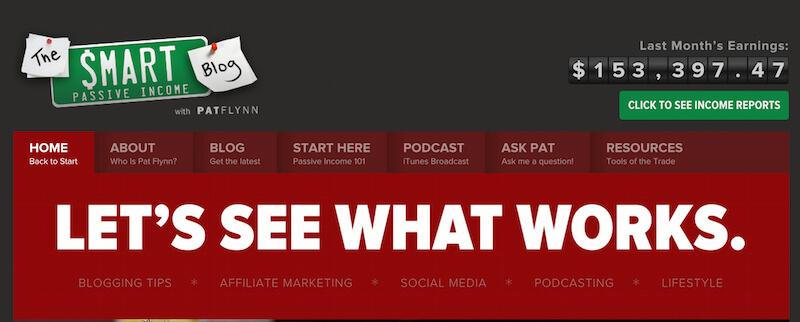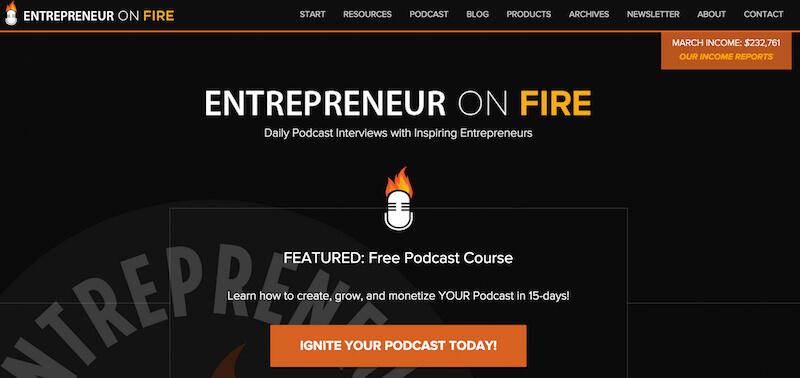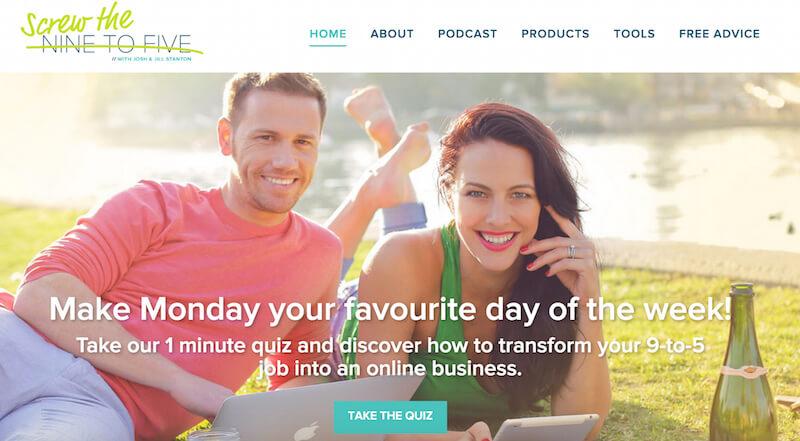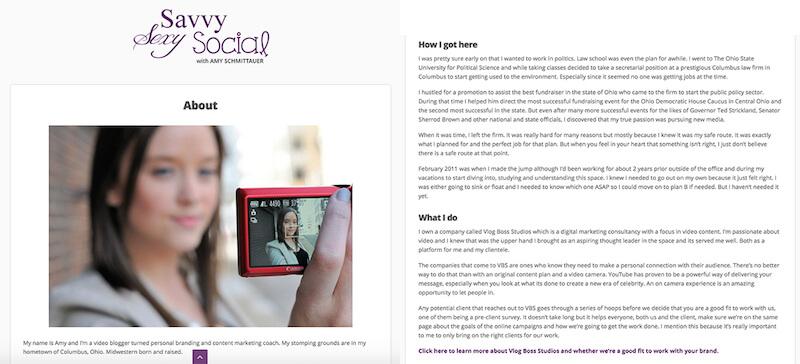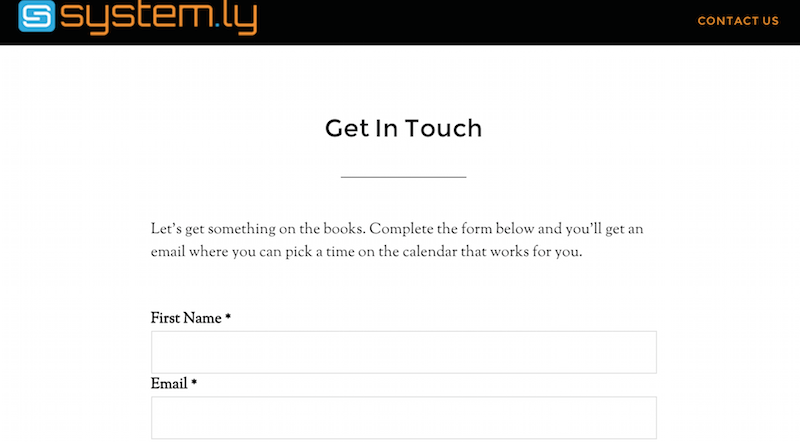Now that you know the core essentials for building a strong foundation for your business (mindset, finding a viable business idea, defining your avatar, niching down, and building relationships), it’s time to create your platform.
How to start creating your platform
Your platform is made up of 4 main elements, and the importance of your platform is unparalleled because it will serve as a support system for your future growth.
It’s important to practice patience when creating your platform because it will take time to get everything in place. Always remind yourself to take imperfect action – it’s better than no action at all!
Let’s take a look at how you can get started with each of the 4 main elements.
4 Main elements of your platform
1. Your website
Your website is your home base: a place where your audience and potential customers can go in order to consume the valuable content and resources you’re providing, and also a place where they can get to know you better and connect with you.
Once your potential audience members are on your site, you have the opportunity to prove that you have what they want and need most so they’ll continue coming back, but sometimes you only have seconds to grab their attention.
Here are 5 things that can help you get started with building your website around the content that’s most important.
5 Things every website needs
1. Easy navigation
Giving your visitors easy-to-use navigation is one of the most critical pieces of your site. If you’re not making it easy for people to find what they’re looking for, chances are they aren’t going to stick around to figure it out themselves.
Here’s an example of a site with clear and easy-to-use navigation: Pat Flynn’s Smart Passive Income:
Notice that Pat gives his visitor a clear navigation bar so they can go directly to the content they want most:
About | Blog | Start Here | Podcast | Ask Pat | Resources
2. A clear message
After landing on your home page, your visitor shouldn’t have to guess whether or not they’re in the right place, or what the next step is that they should take. Make it very clear what your message is, why your visitor should care, and don’t be afraid to tell them what to do once they’re there.
Make it easy for them to stick around by letting them know you have content, resources – even products and services – that can help solve their biggest pain points and that will help them in accomplishing what it is they want most. This way, you’ll not only gain a fan, but also a repeat visitor.
Here’s an example of a site with a clear message: Hey! That’s us at EOFire :)
One of the first things our visitors see when they hit our home page is a concise, clear description of what EntrepreneurOnFire provides:
Daily Podcast Interviews with Inspiring Entrepreneurs
So even if someone is visiting our site for the first time, we’re giving them a clear description of what they can expect.
Also, we give them a call to action, which rotates on a regular basis in our “FEATURED” section. This is an opportunity for our visitors to opt in to one of our email lists.
3. Opt in giveaway
If you’re looking to launch a successful and sustainable business, then one of your top goals should be to start growing your email list. This is your one and only direct connection to your fans and followers that you own.
How do you start growing your email list?
Well for starters, you need to have people coming to your website. More on this in the next chapter…
But once you do have people coming to your site, you want to have something of value to give away in exchange for your visitor’s email address.
This is oftentimes called an opt in giveaway, and it’s a piece of content – an ebook or a PDF download of some sort – that hits home with your avatar: when they read the title, they want it instantly and are more than happy to give up their email address in exchange.
You also want to give them a compelling reason to stay on your list, so rather than just send them a giveaway and then never reach out to them again, take the time to set up an auto responder welcome series that introduces your email subscribers to your business and what they can expect as a subscriber.
One email a week is a good place to start.
Your auto responder series might include emails that answer the following questions:
- Who are you?
- What do you have to offer your subscribers?
- Why should they care?
- What can they expect in the future?
Here’s an example of a site with a great opt in giveaway: Jill & Josh Stanton’s Screw The Nine to Five:
Jill and Josh are speaking directly to their avatar with their opt in copy:
Make Monday your favourite day of the week!
They know their avatar’s biggest pain point is getting out of their 9 to 5 and into entrepreneurship, and so giving them the opportunity to turn their least favorite day into their favorite day is definitely going to appeal to them.
4. About page
I’m sure you’ve heard this more than once, but it really is absolutely necessary to have a well-crafted About page.
As one of the most visited pages on your site, it’s important that your About page speaks to your visitor. This is your opportunity to really connect with them.
The #1 piece of information visitors are looking for when they hit your About page: What can you, your site, your products, and your services do for me?
Seems kind of funny that an About page isn’t even really about you, huh?
Well, don’t take that thought too far, because it is supposed to be a little bit about you. You definitely want to create the opportunity for your visitor to connect with you personally, so don’t be afraid to share your unique personality and a bit about your background.
Some ways you can do this are to include things like:
- Your name and where you live;
- A bit about your family life (are you married, do you have kids?…)
- Some pictures of you doing the things you love;
- A blurb about why you started your business/website/blog
Here’s an example of a site with a great About page: Amy Schmittauer’s Savvy Sexy Social (Sorry! This link was active when this episode was first published in 2014. This resource is no longer available.)
Amy’s about page speaks directly to what she has to offer her visitor – and in the process, it tells them about who she is.
A great About page will combine the two seamlessly.
5. Contact page
Of course you want people to be able to get in touch with you!
Your Contact page should include an email form (or just an email address they can use to get in touch with you), any applicable information about your business (location, your terms & conditions, and the like), along with your social media handles so people can connect with you.
Here’s an example of a site with a solid Contact page: Greg Hickman’s System.ly
Greg’s Contact page makes it easy for his visitor to do anything they want to do: email him, connect with him on social media, or search for content on his site.
2. Your content
Now that you have your site up and running, you’re going to need to create some type of content to share on it.
The content you create should serve your avatar directly, and ultimately, your avatar is looking for something that will:
1. Solve a pain point they’re experiencing, and
2. Is delivered in such a way they don’t want or need to go anywhere else for it.
Your content – whether it’s in the form of a podcast, blog post, guide, video course, or your weekly email newsletter – is what’s going to help people decide if what you’re offering is something they want.
Don’t skimp on your content.
This is your chance to make a great impression for those who might be visiting your site for the first time, and also your chance to provide real value to your audience on an ongoing basis, which is ultimately what will get people to stick around.
Once you’re able to provide people with the type of content they want and need, they’ll become loyal followers, and you’ll become an authority figure in your niche.
3. Be social!
People love being on social media; open the doors for them to connect with you while they’re there!
Depending on your business, some social platforms may be better than others. Do some research to find out where you can make the biggest impact for your business before you start creating profiles anywhere and everywhere.
I recommend starting your platform out with one primary social media account / platform, and then expanding from there. Choose your one platform and make that your focus.
Being active on your social media channels is a great way for you to engage with and get to know your audience (and vice versa!)
Posting questions, or even sending out surveys on social media can give you key insights into what your audience is truly searching for.
In addition, social media gives you an opportunity to share other people’s content that you know will benefit your audience. Doing so helps you build strong relationships within your industry (by sharing and supporting others’ content), and with your audience (by delivering value to them – regardless of whether it’s your own or someone else’s.)
Don’t feel overwhelmed by this step of creating your platform. It’s important to start with a single social media platform and focus based on where you know your audience is and where you’re willing and able to commit your time to being, too.
This will ensure you’re able to make the biggest impact while still having control over your platform.
A quick example: if your audience isn’t on Pinterest, then why create a business profile there?
Start with one, and then you can continue to grow your social media platform from there. Be smart with your time and resources – you only have so much of them.
4. Leverage multiple mediums
Leveraging multiple mediums is a strategy that will spark your exposure and jumpstart the growth of your audience, which is why I like to include this as one of the four main elements to creating your platform.
What’s a platform if no one knows about it?
We talked earlier about actually getting people to your website, and leveraging multiple mediums is what will help you do just that.
So what does leveraging multiple mediums mean, exactly?
Essentially, it’s about being seen in several places instead of just one.
As an example, let’s say that you’ve created a website and your main medium to share your content with your audience is via a podcast. But just because your main medium is your podcast doesn’t mean you can’t share that content across multiple mediums (instead of just one) in order to reach a wider audience and gain exposure.
So instead of just publishing a podcast episode and having that episode show up in iTunes, you might also post a show notes page on your website, a video teaser on YouTube, and advertise the episode on social media.
The benefits are endless: by leveraging multiple mediums you’re able to…
- reach a wider audience,
- have more people find value in the content you’re providing,
- and all the while, you’re build even more authority and credibility in your niche.
Plus, leveraging multiple mediums to publish your content doesn’t mean double or triple the work.
Finding ways to repurpose your content on multiple mediums is becoming increasingly popular, and it’s a smart way to maximize the content you’re already spending time to create.
My podcast, Kate’s Take, is a perfect example of this: instead of just publishing blog posts and leaving it at that, I also leverage this content to record podcast episodes, social media posts, and I’ve even turned the posts you’re reading right now into a book that I’ve self-published on Amazon, The Fire Path!
Time to take action!
Now that we’ve covered the 4 main elements of creating your platform, you have all the necessary steps to forge ahead with growing your audience.
But before we move on, remember that your platform isn’t something you create overnight; it takes time and is something that will continue to grow and evolve overtime.
A great place to start is to think about what each of these elements might look like for you and your business, and then, over the next several days (or weeks depending on your schedule), start writing out a strategy and plan for how you’re going to implement each of these elements.
Go ahead! Write out your platform strategy so you have a reference for what steps to take next based on the elements we covered in this post!
All right – it’s growth time, baby!
Now that you have your platform, it’s time to start building trust and loyalty through consistency so that you don’t just have a 1-time visitor to your site, but a lifetime fan.

